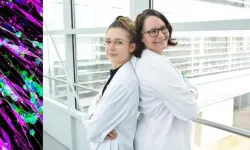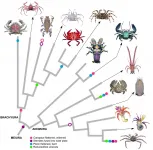Shutting the nano-gate
Researchers at Osaka University create voltage-controlled nanopores that can trap particles as they try to pass through, which may lead to single-molecule sensors, along with cheaper and faster genomic sequencing
2021-03-12
(Press-News.org) Osaka, Japan - Scientists from the Institute of Scientific and Industrial Research at Osaka University fabricated nanopores in silicon dioxide, that were only 300 nm, in diameter surrounded by electrodes. These nanopores could prevent particles from entering just by applying a voltage, which may permit the development of sensors that can detect very small concentrations of target molecules, as well as next-generation DNA sequencing technology.
Nanopores are tiny holes that are wide enough for just a single molecule or particle to pass through. The motion of nanoparticles through these holes can usually be detected as an electrical signal, which makes them a promising platform for novel single-particle sensors. However, control of the motion of the particles has been a challenge so far.
Scientists at Osaka University used integrated nanoelectromechanical systems technology to produce solid-state nanopores, only 300 nm wide, with circular platinum gate electrodes surrounding the openings that can prevent nanoparticles from passing through. This is accomplished by selecting the correct voltage that pulls ions in the solution to create a countervailing flow that blocks the entry of the nanoparticle.
"Single-nanoparticle motions could be controlled via the voltage applied to the surrounding gate electrode, when we fine-tuned the electroosmotic flow via the surface electric potential," first author Makusu Tsutsui says. After the particle has been trapped at the nanopore opening, a subtle force imbalance between the electrophoretic attraction and the hydrodynamic drag can then be created. At that time, the particles can be pulled in extremely slowly, which may allow long polymers, like DNA, to be threaded through at the correct speed for sequencing.
"The present method can not only enable better sensing accuracy of sub-micrometer objects, such as viruses, but also provides a method for protein structural analysis," senior author Tomoji Kawai says. While nanopores have already been used to determine the identity of various target molecules based on the current generated, the technology demonstrated in this project may allow for wider range of analytes to be tested this way. For example, small molecules, such as proteins and micro-RNA segments that need to be pulled in at a very controlled speed, may also be detected.
INFORMATION:
The article, "Field effect control of translocation dynamics in surround-gate nanopores," was published in Communications Materials at DOI: https://doi.org/10.1038/s43246-021-00132-3
About Osaka University
Osaka University was founded in 1931 as one of the seven imperial universities of Japan and is now one of Japan's leading comprehensive universities with a broad disciplinary spectrum. This strength is coupled with a singular drive for innovation that extends throughout the scientific process, from fundamental research to the creation of applied technology with positive economic impacts. Its commitment to innovation has been recognized in Japan and around the world, being named Japan's most innovative university in 2015 (Reuters 2015 Top 100) and one of the most innovative institutions in the world in 2017 (Innovative Universities and the Nature Index Innovation 2017). Now, Osaka University is leveraging its role as a Designated National University Corporation selected by the Ministry of Education, Culture, Sports, Science and Technology to contribute to innovation for human welfare, sustainable development of society, and social transformation.
Website: https://resou.osaka-u.ac.jp/en
[Attachments] See images for this press release:

ELSE PRESS RELEASES FROM THIS DATE:
2021-03-12
Researchers at UCL have solved a major piece of the puzzle that makes up the ancient Greek astronomical calculator known as the Antikythera Mechanism, a hand-powered mechanical device that was used to predict astronomical events.
Known to many as the world's first analogue computer, the Antikythera Mechanism is the most complex piece of engineering to have survived from the ancient world. The 2,000-year-old device was used to predict the positions of the Sun, Moon and the planets as well as lunar and solar eclipses.
Published in Scientific Reports, the paper from the multidisciplinary UCL Antikythera Research Team reveals a new display ...
2021-03-12
PHILADELPHIA -- (March 12, 2021) -- Scientists at The Wistar Institute identified a new function of ADAR1, a protein responsible for RNA editing, discovering that the ADAR1p110 isoform regulates genome stability at chromosome ends and is required for continued proliferation of cancer cells. These findings, reported in Nature Communications, reveal an additional oncogenic function of ADAR1 and reaffirm its potential as a therapeutic target in cancer.
The lab of Kazuko Nishikura, Ph.D., professor in the Gene Expression & Regulation Program of The Wistar Institute Cancer Center, was one of the first to discover ADAR1 in mammalian cells and to characterize the process of RNA editing ...
2021-03-12
A factor that turns malignant tumors into benign ones? - That is exactly what scientists at St. Anna Children's Cancer Research Institute have discovered. Together with colleagues from the Medical University of Vienna and the University of Vienna (Faculty of Chemistry), they studied tumors of the peripheral nervous system in children, namely neuroblastomas. The scientists discovered that the uncontrolled growth of benign neuroblastomas is stopped by a signal molecule produced by Schwann cells present within these tumors. This natural "brake" also works on malignant neuroblastoma ...
2021-03-12
Brominated flame retardants (BFRs) are found in furniture, electronics, and kitchenware to slow the spread of flames in the event of a fire. However, it has been shown that these molecules may lead to early mammary gland development, which is linked to an increased risk of breast cancer. The study on the subject by Professor Isabelle Plante from the Institut national de la recherche scientifique (INRS) made the cover of the February issue of the journal Toxicological Sciences.
Part of the flame retardants are considered to be endocrine disruptors, i.e. they interfere with the hormonal system. Since they are not directly bound to the material in which they are added, the molecules escape easily. They are then found in house ...
2021-03-12
Chest pain is misdiagnosed in women more frequently than in men, according to research presented today at ESC Acute CardioVascular Care 2021, an online scientific congress of the European Society of Cardiology (ESC).1 The study also found that women with chest pain were more likely than men to wait over 12 hours before seeking medical help.
"Our findings suggest a gender gap in the first evaluation of chest pain, with the likelihood of heart attack being underestimated in women," said study author Dr. Gemma Martinez-Nadal of the Hospital Clinic of Barcelona, Spain. "The low suspicion of heart attack occurs in both women themselves and in physicians, leading to higher risks of late diagnosis and misdiagnosis."
This study examined gender differences in the presentation, ...
2021-03-11
As gatherings to observe whooping cranes join the ranks of online-only events this year, a new study offers insight into how the endangered bird is faring on a landscape increasingly dotted with wind turbines. The paper, published this week in Ecological Applications, reports that whooping cranes migrating through the U.S. Great Plains avoid "rest stop" sites that are within 5 km of wind-energy infrastructure.
Avoidance of wind turbines can decrease collision mortality for birds, but can also make it more difficult and time-consuming for migrating flocks to find safe and suitable rest and refueling locations. The study's insights into migratory behavior ...
2021-03-11
COLUMBUS, Ohio - Overweight low-income mothers of young kids ate fewer fast-food meals and high-fat snacks after participating in a study - not because researchers told them what not to eat, but because the lifestyle intervention being evaluated helped lower the moms' stress, research suggests.
The 16-week program was aimed at preventing weight gain by promoting stress management, healthy eating and physical activity. The methods to get there were simple steps tucked into lessons on time management and prioritizing, many demonstrated in a series ...
2021-03-11
In the field of robotics, metals offer advantages like strength, durability, and electrical conductivity. But, they are heavy and rigid--properties that are undesirable in soft and flexible systems for wearable computing and human-machine interfaces.
Hydrogels, on the other hand, are lightweight, stretchable, and biocompatible, making them excellent materials for contact lenses and tissue engineering scaffolding. They are, however, poor at conducting electricity, which is needed for digital circuits and bioelectronics applications.
Researchers in Carnegie Mellon University's Soft Machines Lab have developed a unique silver-hydrogel composite that has high electrical ...
2021-03-11
Crabs are living the meme life on social media lately. The memes joke that everything will eventually look like a crab. But it's actually based in some truth.
The crab shape has evolved so many times the evolutionary biologist L.A. Borradaile coined the term carcinization in 1916 to describe the convergent evolution process in which a crustacean evolves into a crab-like form from a non-crab-like form. Crabs are decapod crustaceans of the infraorder Brachyura and are considered "true crabs", most of which are carcinized. "False crabs" are of the ...
2021-03-11
As experts nationwide point to a mental health crisis among teens and young adults, a pilot program teaching mindfulness and coping techniques to students at the University of Washington has helped lower stress and improve emotional well-being.
New studies by the psychology researchers who created the program find that the strategies, offered first in residence halls and later through classes and other organized campus groups, have provided participants with successful methods for coping with stress, managing their emotions and learning self-compassion.
Researchers say the results show the potential for preventive mental health services offered in an accessible, peer-group environment.
"This program is not a substitute ...
LAST 30 PRESS RELEASES:
[Press-News.org] Shutting the nano-gate
Researchers at Osaka University create voltage-controlled nanopores that can trap particles as they try to pass through, which may lead to single-molecule sensors, along with cheaper and faster genomic sequencing






